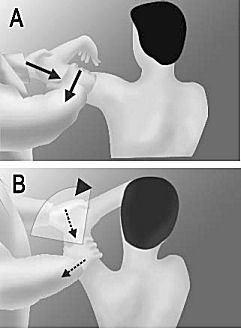Kim test: Difference between revisions
No edit summary |
Kim Jackson (talk | contribs) m (Text replacement - "Category:Assessment and Examination - Shoulder" to "Category:Shoulder - Assessment and Examination") |
||
| (25 intermediate revisions by 11 users not shown) | |||
| Line 1: | Line 1: | ||
<div class="editorbox"> | |||
'''Original Editor '''- [[User:Sarah McBride|Sarah McBride]] | |||
'''Top Contributors''' - {{Special:Contributors/{{FULLPAGENAME}}}} | |||
</div> | |||
== Purpose == | |||
Detection of a posteroinferior labral lesion.<br> | |||
== Technique == | |||
A - With the patient in a sitting position with the arm 90 degrees of abduction, the examiner holds the elbow and lateral aspect of the proximal arm, and a strong axial loading force is applied. | A - With the patient in a sitting position with the arm 90 degrees of abduction, the examiner holds the elbow and lateral aspect of the proximal arm, and a strong axial loading force is applied. | ||
B - while the arm is elevated 45 degrees diagonally upward, downward and backward force is applied to the proximal arm. A sudden onset of posterior shoulder pain indicates a positive test result, regardless of accompanying posterior clunk of the humeral head. | B - while the arm is elevated 45 degrees diagonally upward, downward and backward force is applied to the proximal arm. A sudden onset of posterior shoulder pain indicates a positive test result, regardless of accompanying posterior clunk of the humeral head. | ||
< | {| width="100%" cellspacing="1" cellpadding="1" | ||
|- | |||
| [[Image:Kim test.jpg]] | |||
| {{#ev:youtube|3SidX4hb3m8|300}}<ref>Clinically Relevant Technologies, http://www.youtube.com/watch?v=1E-ShcJbueM; Accessed May 2011</ref> | |||
|} | |||
== Evidence == | |||
The sensitivity of the Kim test was 80%, specificity was 94%. The interexaminer reliability between 2 examiners was 0.91<ref name="Am J Sports Med">1. SH Kim et al. A Novel Test for Posteroinferior Labral Lesion of the Shoulder—A Comparison to the Jerk Test Am J Sports Med - 01-AUG-2005; 33(8): 1188-92</ref>. | |||
The accuracy of the jerk test in detecting a posteroinferior labral lesion was the following: sensitivity, 73%; specificity, 98%. | The accuracy of the jerk test in detecting a posteroinferior labral lesion was the following: sensitivity, 73%; specificity, 98%<ref name="Am J Sports Med" />. | ||
The Kim test was more sensitive in detecting a predominantly inferior labral lesion, whereas the jerk test was more sensitive in detecting a predominantly posterior labral lesion. The sensitivity in detecting a posteroinferior labral lesion increased to 97% when the 2 tests were combined<ref name="Am J Sports Med" />. <br> | |||
== References == | |||
< | <references /> | ||
[[Category:Assessment]] | |||
[[Category:Shoulder]] | |||
[[Category:Special_Tests]] | |||
[[Category:Shoulder - Special Tests]] | |||
[[Category:Shoulder - Assessment and Examination]] | |||
[[Category:Musculoskeletal/Orthopaedics]] | |||
[[Category:EIM_Residency_Project]] | |||
[[Category:Sports Medicine]] | |||
[[Category:Sports Injuries]] | |||
[[Category:Athlete Assessment]] | |||
Latest revision as of 16:16, 29 August 2019
Original Editor - Sarah McBride
Top Contributors - Admin, Sarah McBride, Kim Jackson, Tony Lowe, Dan Rhon, Clinically Relevant, Evan Thomas, Naomi O'Reilly, Kai A. Sigel, WikiSysop and Wanda van Niekerk
Purpose[edit | edit source]
Detection of a posteroinferior labral lesion.
Technique[edit | edit source]
A - With the patient in a sitting position with the arm 90 degrees of abduction, the examiner holds the elbow and lateral aspect of the proximal arm, and a strong axial loading force is applied.
B - while the arm is elevated 45 degrees diagonally upward, downward and backward force is applied to the proximal arm. A sudden onset of posterior shoulder pain indicates a positive test result, regardless of accompanying posterior clunk of the humeral head.

|
[1] |
Evidence[edit | edit source]
The sensitivity of the Kim test was 80%, specificity was 94%. The interexaminer reliability between 2 examiners was 0.91[2].
The accuracy of the jerk test in detecting a posteroinferior labral lesion was the following: sensitivity, 73%; specificity, 98%[2].
The Kim test was more sensitive in detecting a predominantly inferior labral lesion, whereas the jerk test was more sensitive in detecting a predominantly posterior labral lesion. The sensitivity in detecting a posteroinferior labral lesion increased to 97% when the 2 tests were combined[2].
References[edit | edit source]
- ↑ Clinically Relevant Technologies, http://www.youtube.com/watch?v=1E-ShcJbueM; Accessed May 2011
- ↑ 2.0 2.1 2.2 1. SH Kim et al. A Novel Test for Posteroinferior Labral Lesion of the Shoulder—A Comparison to the Jerk Test Am J Sports Med - 01-AUG-2005; 33(8): 1188-92






